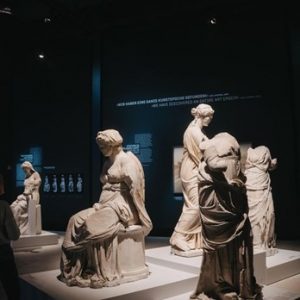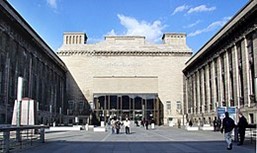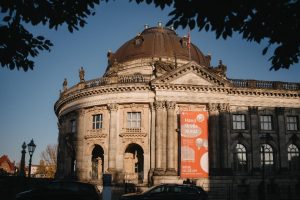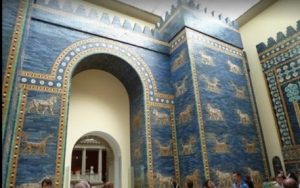
Pergamon museum in Berlin
Berlin Pergamon Museum, Photo by Simon Detel
Prof. Dr. Moustafa El-Abdallah Al Kafry
The Pergamon Museum in Berlin contains precious treasures, timeless architecture and unique works of art, covering 6,000 years of human history. The museum itself is even a UNESCO World Heritage Site, along with five other museums on Berlin’s Museum Island. Located in the middle of the Spree River, the island is one of Berlin’s most popular visiting sites and one of the most important museum gatherings in Europe.
Berlin Pergamon Museum, Photo by Simon Detel
The Pergamon Museum in Berlin is one of the important museums in the city, and it is located inside the Museum Island on the banks of the St.Prey River, which is one of the most important tourist attractions in Berlin, which includes historical and artistic monuments dating back to four thousand years BC.
The Pergamon Museum was established in 1899, named after the art and antiques dealer Heinz Bergeron, as this museum consists of three wings containing the most famous exhibits from various Babylonian, Assyrian and Urukian civilizations, in addition to some contemporary artworks by the most famous artists such as Picasso and Matisse.
Here you will find a magnificent reconstruction of historical buildings. These include the Pergamon Altar, which gave the museum its name, and the Ishtar Gate, which is one of the ancient wonders of the world.
Label: Pergamon Museum, name attribution, Pergamon
Architectural style: neoclassical architecture
Architect: Alfred Meisel
One of the most important public museums in the Federal Republic of Germany. It houses historical monuments and arts from several civilizations, the oldest of which dates back to approximately four thousand years BC. The Pergamon Museum Museum is located on Museum Island in the heart of Berlin. The building consists of two floors in addition to an underground basement with a partial area, consisting of three main wings:
1 – The collection of classical monuments that occupy the architectural halls
2 – Sculpture Pavilion,
3 – The Museum of the Ancient Near East, and the Museum of Islamic Art, arranged around a courtyard containing a forum where all visitors meet.
In addition, the museum offers a renewed program of temporary special exhibitions, aimed at presenting multiple cultures and civilizations with a variety of themes.
Berlin Bodhi Museum, Photo by Simon Detel
The building was built in the period between (1910-1930) in the neoclassical style, and for the uniqueness of the museum’s architectural building, and the antiques and antiquities it contains, the World Heritage Committee of the United Nations Educational, Scientific and Cultural Organization (UNESCO) decided to include the museum in the list of World Heritage Sites in 1999 to preserve it for future generations along with the island’s museums. . In 2012, a restoration project aimed at closely integrating the museum with other museums on Museum Island began, including the construction of the fourth wing, which will house the Museum of Archaeological Architecture of Egyptian Civilization. The project is expected to be completed before 2025. [1]
The museum is managed by the Prussian Cultural Heritage Foundation, one of the world’s largest cultural institutions in the field of preservation of archaeological treasures and works of art.[2]
1 – Date of establishment of the museum:
The museum building was built earlier (1897-1899) by German engineer Fritz Wolff (1847-1921). It was inaugurated in December 1901 by Kaiser Friedrich Wilhelm II (1859-1941). Archaeological excavations and excavations were still underway in Babylon, Uruk, Assyria, Miletus, and elsewhere in the world, and to display recent finds in suitable spaces, the German historian Wilhelm von Bode presented (1845-1929) The Royal Museum evaluated a proposal for a new building for the museum in the same current location. In addition to this proposal, the German engineer Alfred Meisel presented the engineering drawings and construction plans in 1906, but Meisel (1853-1909) left early, and he did not have the opportunity to implement the project. The museum building was constructed with minor modifications (1907-1930) under the direction of the engineer’s close friend, the German engineer Ludwig Hoffmann (1852-1932).
2 – Museum Sections:
2.1 Classical Antiquities Collection:
The classical section of the Pergamon Museum includes the altar of Zeus, and because of its magnitude occupies a very spacious hall, filled with drawers and containing at the bottom sculptures representing the struggle of the Olympic god against the titans, in addition to sculptures, vases, inscriptions and mosaics.
The long period of cultural history, which includes the overlap of civilizations of ancient Greece and ancient Rome, or what is known as the Classical Patropic, is a period of history in which Greek culture abounded with many aspects of civilization. Stories over 2,100 years old are told through architecture, sculptures, vases, engravings and mosaics, as well as bronzes and jewelry, and the Acropolis The historical Bergama of the Aeolus region, made up of thousands of pieces paved next to each other, tells the story of his kingdom, through a series of consecutive scenes, depicting the events of that time period.
2.2 Ancient Near East:
The section of the ancient Near East, which contains the Ishtar Gate, the first gate in human history and the main road of Babylon, all of which were transferred from its Mesopotamian position to the Pergamon Museum in Berlin, as well as cuneiform drawings and writings on clay tablets.
Ancient Ishtar Gate
Through the ancient Ishtar Gate, and through the procession road, which is the main road of the historic city of Babylon, in addition to drawings and cuneiform writings on clay, stone, wax and metal tablets, he wrote down public life affairs, literature, legends, religious affairs and worship. In addition to a unique collection of ceramics, pottery and many treasures and artifacts of civilization, art and culture, from its features, livelihoods, imagination and others, the oldest of which dates back to about 6000 years of the Neolithic Age, which varied among the civilizations that originated in that region, and is considered one of the most important oriental monuments in the world.
2.3 Islamic Art:
It is the oldest museum dedicated to Islamic art, and the largest in Europe and America. It houses 93,000 masterpieces and relics of Islamic art, representing a range of regions of the Islamic world throughout the ages from the eighth to the nineteenth centuries. Through the journey of the Arabic letter in a beautiful and moving form, through the creative language formulated by the artist expressing his ideas and feelings, he was characterized by eloquence that it is one of the features of art in the East, as well as Decorations that are described as the language of Islamic art. In addition to handicrafts, glass artifacts, oriental carpets, ivory sculptures, jewelry and rare manuscripts, which are characterized by beauty.
The museum also includes many halls that contain architectural galleries that have been fully transferred to the museum, in addition to the sculpture pavilion, and many sculptures, mosaics and statues of different temporal rights.
The Pergamon Museum in Berlin, Germany is rich in many historically and culturally expensive artifacts, as it contains a cultural diversity that made it on the UNESCO World Heritage List, making it one of the most important museums globally.
Prof. Dr. Moustafa El-Abdallah Al Kafry
Faculty of Economics – Damascus University
References:
- Project ID at arch INFORM: 11829. Mentioned in: Arch Inform. Access: 05 November 2018. Working language or name language: German.
- Press announcement (in German). © Prussian Cultural Heritage Foundation. Archived 7 March 2016 at the Wayback Machine.
- Press conference statement 18 April 2014 (in German). © Prussian Cultural Heritage Foundation. Archived September 24, 2015, at the Wayback Machine.
- https://ar.wikipedia.org/wiki/%D9%85%D8%AA%D8%AD%D9%81_%D8%A8%D9%8A%D8%B1%D8%BA%D8%A7%D9%85%D9%88%D9%86
[1] – Press Announcement (in German). © Prussian Cultural Heritage Foundation. Saved version 07 Mar 2016 on Wayback Machine.
[2] – Press Conference Release 18 April 2014 (in German). © Cultural Heritage Foundation Prussian. Saved version September 24, 2015 on the site Wayback Machine.



